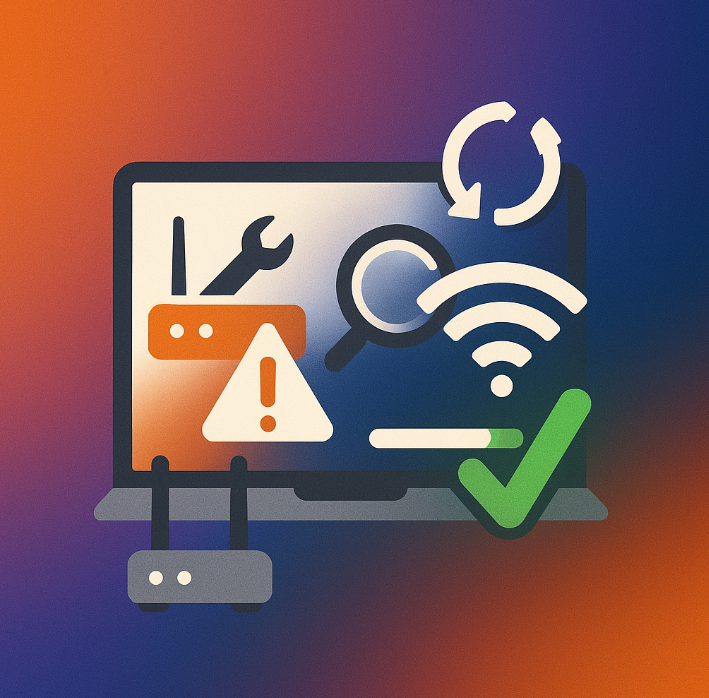Diagnosing Internet Speed Problems
Slow internet can be incredibly frustrating. Whether you're trying to enjoy your favourite Netflix series, connect with family on video calls, or simply browse websites, slow speeds disrupt everyday life. If you're experiencing lagging videos, buffering streams, or web pages loading slowly, you're not alone - it's a common problem for many home users across the Central Coast.
The good news? Diagnosing and solving internet speed issues at home is often simpler than you think. This straightforward guide walks you through identifying the cause of your slow internet and how you can fix it yourself, as well as when you should call in professional help from your local IT experts at Zelrose IT.
What Causes Slow Internet Speeds?
Understanding why your internet might be slow is key to solving the issue quickly. Common reasons include:
Poor Wi-Fi signal strength:
Distance or obstructions between your device and the router can weaken your signal.Router problems:
An outdated or overloaded router can slow your speeds.Bandwidth overload:
Too many devices or demanding activities (like streaming or gaming simultaneously) can slow down your connection.ISP (Internet Service Provider) issues:
Sometimes your provider has network issues, reducing your overall internet speed.Computer/device issues:
Malware, software updates, or outdated hardware can also slow down your internet speed.
Let’s explore how to diagnose these problems easily at home.
Simple Steps to Diagnose Your Internet Speed Issues
Step 1: Perform an Internet Speed Test
The first and simplest step is to test your internet speed:
Visit a reliable site such as speedtest.net.
Click "Go" to run a quick test.
Your result shows Download Speed, Upload Speed, and Ping (response time):
Download Speed affects how quickly videos, webpages, and images load.
Upload Speed matters when sending files, emails, or video calling.
Ping impacts responsiveness - important for gaming or video calls.
If your speed is significantly lower than your plan promises, there’s an issue worth investigating further.
Step 2: Check Your Router Placement
Router location significantly affects Wi-Fi speeds:
Ensure your router is central, elevated, and clear of obstacles.
Try moving closer to the router - if speeds improve, consider repositioning the router or adding an extender.
See our detailed article on Optimizing Router Placement for Speed.
Step 3: Restart Your Modem and Router
A simple restart often resolves speed problems:
Unplug your modem and router for at least two minutes.
Plug them back in and wait a few minutes to fully reconnect.
Retest your speed after restarting.
For detailed steps, check out our guide: How to Reset Your Home Modem and Router.
Step 4: Evaluate Connected Devices
Having too many connected devices can slow your internet:
Temporarily disconnect devices not in use.
Retest your speed. If improved, it indicates an overloaded network.
Step 5: Check for Interference
Other devices in your home (such as microwaves or cordless phones) can interfere with your Wi-Fi signal:
Move your router away from these devices.
Change your Wi-Fi channel to reduce interference (guide here: Best Wi-Fi Channels and Band Settings).
Advanced Diagnostic Steps (Easy & Safe)
If you’re comfortable, here are additional steps to pinpoint and fix issues:
Update Router Firmware: Regular updates improve performance and security. See how in our article: Updating Router Firmware Safely.
Use a Wired Connection (Ethernet): Temporarily connecting your computer directly to your router can identify if the problem is Wi-Fi-specific.
Check Your Device’s Performance: Make sure your device isn’t running unnecessary updates or malware scans slowing internet speeds. Run antivirus scans and close unused applications.
When Should You Call Zelrose IT?
If you’ve tried the steps above without success, it’s likely time for professional support. Zelrose IT can quickly diagnose deeper issues, provide clear, jargon-free explanations, and offer fast, reliable solutions.
Why choose Zelrose IT?
Local Experts: We’re based right here on the Central Coast and understand local issues.
Friendly, Clear Service: Our team offers advice you can easily understand and trust.
Rapid Resolution: Quick home visits or remote support ensure minimal downtime for you.
Maintaining Fast Internet: Tips for Ongoing Reliability
Keep your internet speeds consistently high by following these easy practices:
Regularly restart your router (once per month).
Update router firmware regularly.
Disconnect unused devices.
Monitor your speeds regularly using simple online speed tests to detect issues early.
Quick Summary: Diagnosing Your Internet Speeds Checklist
Follow these quick steps for diagnosing internet speed issues:
Run a speed test.
Check router placement and interference.
Restart your modem/router regularly.
Evaluate connected devices to avoid overload.
Update router firmware periodically.
If unresolved, call Zelrose IT for expert support.
Fast Internet Speeds with Zelrose IT
Struggling with slow internet doesn’t have to be your daily reality. Our friendly, local team at Zelrose IT is ready to help you regain fast, reliable internet. Whether it’s a quick fix or something more technical, we’re here to simplify your life.
Give us a call today at 0478 843 700 or visit www.zelrose.com.au to book your home visit or remote support session.
Don’t let slow internet frustrate your day - Zelrose IT is here to make things easy again!
Related Posts You Might Like:




